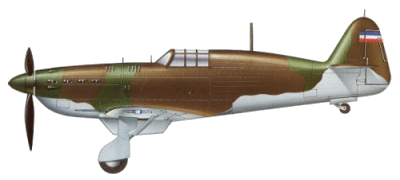
The innovative
processes that were linked to the change from biplane to monoplane
reached the Yugoslavian aeronautical industry, traditionally considered
second-rate compared to those of the major European powers, in the
first half of the 1930s. The result of this was the Rogozarski IK-3, a
small, agile fighter with enclosed cockpit and all retractable landing
gear, which proved to be just as reliable and rather more easy to
handle than its two more illustrious contemporaries, the British Hawker
Hurricane and the German Messerschmitt Bf 109. However, the IK-3 had a
relatively short life span, dictated by the events of the war itself.
The production program came to a halt when the Germans invaded, by
which time only 12 aircraft had been delivered to the units.

In 1933, the idea of
developing a modern combat plane came to Ljubomir Ilic and Kosta Sivcev
the two technicians who had produced the first entirely Yugoslavian
fighter, the IK-1, a couple of years earlier. Encouraged by this
experience, the two designers, along with Slobodan Zrnic were convinced
that the era of the biplane and the high-wing monoplane was over and
that, considering the high-quality performance of the new bombers being
developed at the time, only a low-wing monoplane with retractable
landing gear possessed the characteristics necessary to guarantee
supremacy in the air. The project got under way in great secrecy, and
toward mid 1936 all drawings and documentation were handed over to the
military authorities for examination.

However, the initial
evaluation phase proved to be long, the delay caused to a great extent
by official scepticism concerning the new formula. Not until March of
the following year was a contract signed for the production of a
prototype. The factory that was to supervise its construction was
Rogozarski, based in Belgrade. The first aircraft was completed a year
later, and the IK-3 made its maiden flight near the end of May 1938.
The fuselage had a steel tube airframe with a mixed canvas and metal
covering, and the wing was built almost entirely of wood, with only a
few steel tube reinforcements. The prototype was powered by a 910 hp
(679 kW) "V-12" Hispano-Suiza 12 Y29 engine with supercharger (although
in the production series this was replaced by the equally powerful 12
Ycrs model built by Avia on license), which drove a three-bladed
variable pitch metal propeller. The armament consisted of a 20 mm
cannon installed on the propeller shaft and two fixed machine guns in
the fuselage.

During evaluation
tests, the concentration of the armament in the nose was one of the
most appreciated features, although the aircraft's maneuverability and
excellent overall performance also made a good impression. However,
flight tests were interrupted suddenly on 19 January 1939, when the
prototype crashed to the ground following a deep dive, causing the
death of the test pilot, Milan Pokorni. Even though the causes of the
accident were not attributed to serious structural problems, this event
delayed still further the start of production, which had been planned
on the basis of an order for 12 aircraft barely three months earlier.
The first six aircraft
were delivered in March 1939, and the others by July. The IK-3s
equipped the 161 and 162 Eskadrila, which formed part of the 51st grupa
based at Zemum airfield. Beginning on April 6, 1941, the date of the
German invasion of Yugoslavia, the twelve operational IK-3s proved
their worth in the fierce fighting against the Luftwaffe, destroying
eleven enemy aircraft before last two surviving aircraft were destroyed
at the emergency strip at Veliki Radnici by their crews during the
night of April 11/12. At that time, another 25 aircraft were under
construction.
Specifications (Rogozarsky
IK-3)
Type: Single
Seat Fighter
Design: Ljubomir
Ilic, Kosta Sivcev and Slobodan Zrnic
Manufacturer:
Prva Srpska Fabrika Aviona Zivojin Rogozarsky in Belgrade
Powerplant: One
960 hp (716 kW) Avia built Hispano-Suiza 12Ycrs moteur canon
engine.
Performance:
Maximum speed 327 mph (527 km/h); service ceiling 30,840 ft (9400 m).
Range: 488 miles
(785 km) on internal fuel.
Weight: Empty
equipped 4,559 lbs (2068 kg) with a maximum take-off weight of 5,798
lbs (2630 kg).
Dimensions: Span
33 ft 9 1/2 in (10.30 m); length 26 ft 3 in (8.00 m); height 10 ft 8 in
(3.25 m); wing area 177.6 sq ft (16.50 sq m).
Armament: One
engine mounted 20 mm Oerlikon FF cannon and two fuselage mounted and
synchronised 7.92 mm (0.31 in) FN Browning machine-guns.
Variants:
Rogozarsky IK-3.
Avionics: None.
History: First
flight (prototype) May 1938; first deliveries March 1939; last aircraft
destroyed April 1941.
Operators:
Yugoslavia. |
